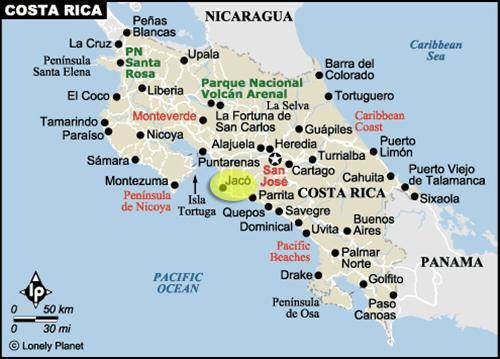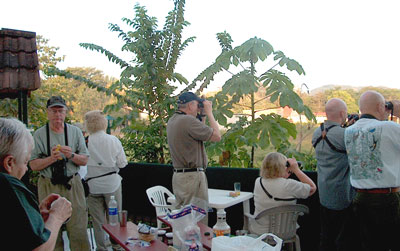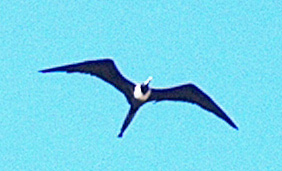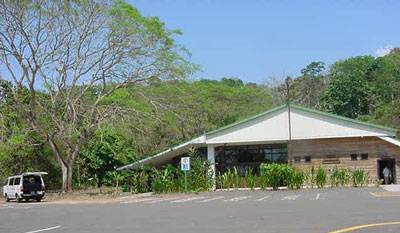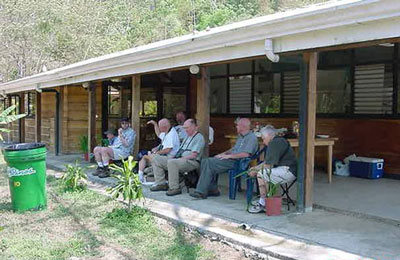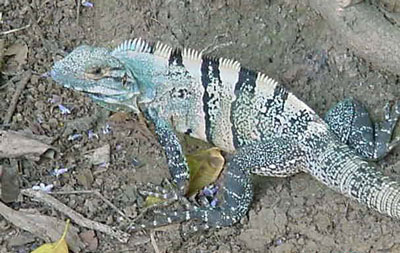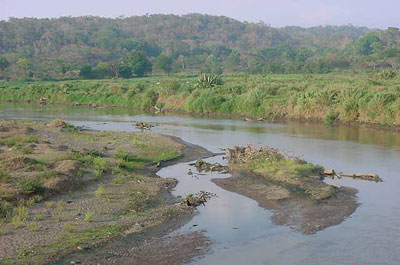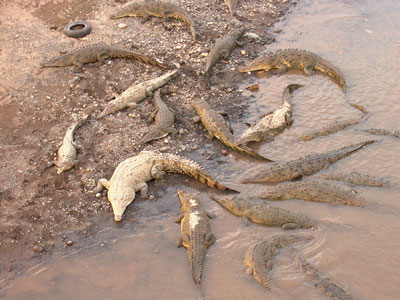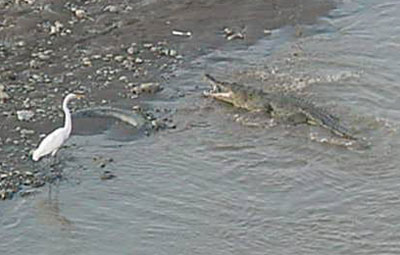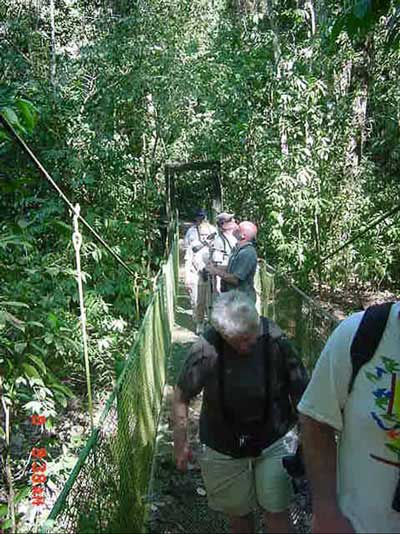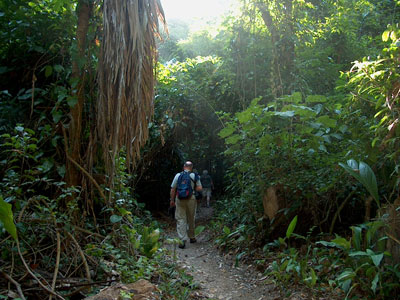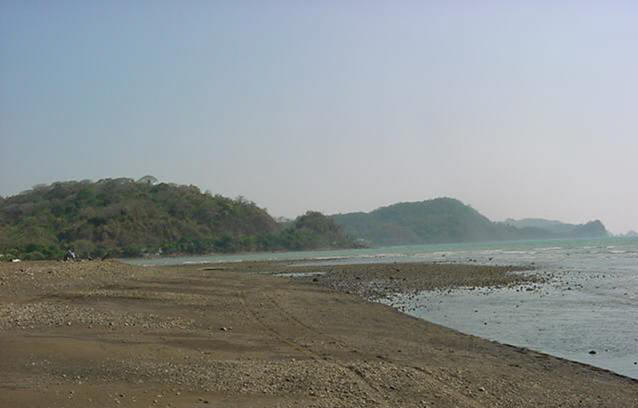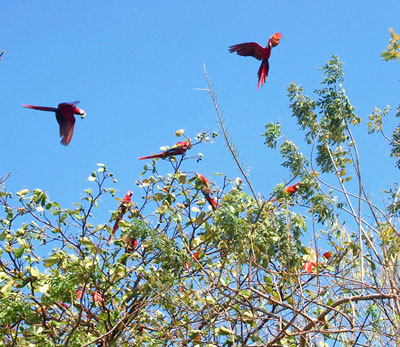|
Costa Rican Birding Adventure
Part 1—The Pacific Slope
The lure of Costa Rica for the avid birder is overwhelming. What other country in the world has a species list of over 900—more than all of North America—and yet is half the size of the State of Utah, is easy to get to, is quite safe by international standards, and is essentially English speaking? For years, I have been dreaming of going to Costa Rica but just could not find the time to get away. When I learned that Bryan and Dennis Shirley were leading another trip there and when I was invited to do some BYU business in the area at about the same time, I jumped at the chance. My only disappointment was that my wife, Claralyn, couldn’t accompany us. Even though we had purchased tickets for the trip, a new granddaughter arrived in the world a few weeks ahead of schedule so Claralyn decided to stay and help the mother. As the departure date approached, the group of Utah County birders began to solidify, finally consisting of Milt Moody, Alton Thygerson and son Scott, Tom Williams, Dennis and Bryan, Tuula Rose, Carol Jean Nelson, LeIla Ogden and Ned Hill. Most of us got together at our home on a February evening to discuss travel plans and get a taste of what to expect on the trip. We were encouraged to study that thick field guide by Stiles and Skutch with its many families of birds totally unfamiliar to US birders: tinamous, antpittas, ant vireos, ant shrikes, ant thrushes (must be a lot of ants in Costa Rica!), toucans, toucanets, aracaris, foliage gleaners, cotingas, manakins, etc. To prepare ourselves for the new sounds we would hear, some of us studied the CDs containing the many exotic calls and songs of Costa Rican birds. Dennis’s slides of previous trips added greatly to our anticipation. Starting the Adventure Early in the morning of March 6th seven of us started from Provo to begin our Costa Rican adventure. The Spotted Towhees were singing their spring song already: "chup, chup, cheeeeeeeeeee" and Chukars were chucking in the foothills. Spring is on its way to the valley. Claralyn drove us to the Salt Lake airport (Tom, Carol Jean and Bryan preceded us to Costa Rica by a day or more). Continental Airlines took us south to Houston. As we waited for our connecting flight, we discussed what we might expect tomorrow. Dennis reported that on his first day in Carara Reserve (our first stop) he saw 76 life birds! That’s more than I saw on my first trip to SE Arizona over a whole week— and I thought I was in heaven then. The anticipation was building. We arrived at San Jose, the capital of Costa Rica at about 10 pm. The hour long line through immigration and customs was reminiscent of those long, snaking Disneyland lines. All luggage made it safely! Exiting the arrival hall we found a very friendly and helpful crowd of people offering to take our bags and transport us anywhere—but there was no Bryan to meet us. Where was he? After looking all around the airport, Dennis called his wife in Utah and discovered that Bryan had been delayed. A head-on collision of two busses on the narrow mountainous road from San Jose to Jacó (where we were to spend our first couple of days) closed the road completely. We were to check into a motel and he’d meet us in the morning. We were disappointed to think that we’d miss a morning of birding in Carara. But we felt terrible about those on the buses (we never did learn what happened but we saw that it would take only a minor accident to close that road). This incident pointed out the need for international standards in the cell phone industry. Like most other nations, Costa Rica uses a different cell phone protocol from the U.S., hence our cell phone don’t work down here. We checked into three rooms at a nearby Hampton Inn. At 1:30 am Bryan called from the front desk—he had taken a dirt road and gone hours out of his way to circumvent the accident and join us. What a trooper! We arose at 5:30 am—poor Bryan—ate a little breakfast highlighted by unusual and delicious fruit drinks and hurried out to see our first Costa Rican birds. We half expected every bird we saw would be an exotic one—but, we started with some familiar species that are common in the US and some even in Utah: A Black-shouldered Kite hovered over the adjacent field and Costa Rica’s national bird, the Clay-colored Robin, perched on the roof. Noisy Great-tailed Grackles were everywhere and Cattle Egret flew across the sky dotted with soaring Black and Turkey Vultures. As we loaded the white van that was to become our traveling home for the next 9 days, we found our first non-US species, a Rufous-collared Sparrows behaving around the motel very much like House Sparrows. On roadside wires, Tropical Kingbirds and Great Kiskadees would become very familiar "junk birds." Jacó
On the road down to Jacó Bryan suddenly stopped the van and yelled, "There’s a toucan." We pulled as far off the narrow road as possible and caught a glimpse of a Keel-billed Toucan sitting in a tree near the side of the road. Its huge bill, long tail and bright yellow face were memorable. Finally a real "jungle bird." Most roads in Costa Rica are narrow and steep. The country was formed from volcanic action and it is relatively young geologically speaking. There are rarely flat places in Costa Rica. Because most roads are built into the sides of mountains, there isn’t much room for shoulders or turnouts. This makes for somewhat dangerous driving and birding but affords spectacular scenery. The western or Pacific slope of Costa Rica is totally different in flora and fauna from the eastern or Caribbean slope. Many bird species prefer either one side or the other. Parts of the Pacific slope are dry and other parts moist. The Jacó area shows some dry areas interspersed with lowland moist jungle. At about 9:00 am we checked into our motel, the Mer de Luz. It is a small motel with a pool, jacuzzi, air conditioning, and adjoining habitat for birds: a brushy field and tree-lined creek. Lowland Costa Rica is very hot and humid. As we unpacked the van, Milt and I checked out some sounds coming from the trees—it turned out to be a colorful songster, a Rufous-naped Wren. Tom and Carol Jean greeted us, having arrived earlier on different flights. A Cherrie’s Tanager—a strikingly black bird with a bright red rump—admired itself in the mirror of a parked RV and Blue-gray Tanagers perched in the open trees. We also saw Common Ground Dove, Inca Dove and House Wren. A Rufous-tailed Hummingbird, the most common, it seems, in Central and South America, sampled nectar at the flowers near the pool.
We did not take much time to bird around the motel since we were anxious to get to Carara. Carara is about 20 minutes back up the highway. We drove past some White Ibis. The road passes near the ocean where we stopped briefly to see literally swarms of Magnificent Frigatebirds in a small bay. A line of Brown Pelicans flew by and many Laughing Gulls sauntered on the beach.
|
|||||||
Carara Reserve Outside the Carara Visitor’s Center we immediately began seeing forest species: the colorful Yellow-throated Euphonia, the strikingly gorgeous Blue Dacnis (both small tanagers), and a Yellow-throated Vireo (a US migrant). We drove a short distance to the turnout near the Tarcoles River Bridge and parked our van in the small parking area. At about 11 am we started walking down a 4 km trail in the heat and humidity. This was secondary growth forest and relatively open. Unfortunately, we missed the cool morning hours when birds are much more active but we began seeing interesting species: White-shouldered Tanager, the huge Barred Woodcreeper and the striking Masked Tityra. A Red-legged Honeycreeper was amazing with its brilliant shades of blue with bright red legs. A White-tipped Dove gave its mournful whistle and a Black-headed Trogon looked splendid with its bright yellow belly, black head and black & white tail. We found a Black-hooded Antshrike one of those secretive forest floor species. The Long-billed Gnatwren was a lifer for everyone including Bryan and Dennis. We saw our first and only Jacamar: the Rufous-tailed Jacamar related to the kingfishers. The Squirrel Cuckoo is aptly named—its coloration and long tail look very much like a squirrel from a distance. Hoffmann’s Woodpecker was the most common woodpecker of the trip. A Plain Xenops worked branches like a miniature woodpecker. We checked our footing carefully when we birded the area where Dennis and Bryan had found a Bushmaster snake on their last trip. When we reached the oxbow or resaca, we found it dry with no anticipated Boat-billed Herons. They have always found them here before—but they have also found water here before. Instead of water, grasses grew. We found a few Bare-necked Tiger-Herons and a Green Heron. Way off in the distance, Bryan spotted a perching Turquoise-browed Motmot. We got the scope on it so all could see. We heard Great Tinamou but we never saw a tinamou the entire trip—all were "heard only." Bryan realized that he had left his shoulder pack somewhere on the trail. As we returned to the van, we did not find any pack. More disconcerting was that when we reached the van, we discovered that a window had been forced and that LeIla’s fanny pack was gone. It held her $500 digital camera and some prescription medications. What a shame. We drove back to the visitor’s center—really just a small office and some bare rooms—to sit on the porch and eat lunch. To our surprise, three or four Black Iguanas (also called Ctenosaurs) approached us begging to be fed. They were like little dogs. They loved cheese and meat and Dennis even got one to "sit up"—at least it jumped up a bit to catch something.
|
|||||||
|
Tarcoles
We drove down towards the town of Tarcoles. In some fields we saw Blue-black Grassquits and Groove-billed Anis. At a pond off the road we found a beautiful American Pygmy Kingfisher in colorful blue, cinnamon and white. Here we also saw Green Heron, Louisiana Waterthrush, Summer Tanager, Bare-throated Tiger-Heron and Orange-chinned Parakeet.
We ate dinner at a great restaurant and then converged in the Shirley’s room
for our daily ritual: tallying up "the list." It must be something akin to
fishermen counting up their catch. We go over the checklist and everyone marks
down the birds they and the group saw. Memories are refreshed and exciting finds
relived. Not everyone, of course, sees every bird. But most are seen by all. A
few in the group swam in the pool while others retired early after a long, hot,
thrilling day. |
|||||||
Carara Again—Primary Forest
We were up at 5:30 to gather on the motel balcony to enjoy a light breakfast provided by Bryan and Dennis. Early rising would become a hallmark of the trip. The balcony commands a nice view of the field next to the motel and some distant trees favored by birds. Bryan had his scope set up. We saw Red-billed Pigeon, Palm Tanager, White-collared Seedeater (these make it up into southern Texas), House Wren, Rufous-naped Wren, Cherrie’s Tanager, Blue-Black Grassquit, and Baltimore Oriole. A little Common Tody Flycatcher worked the tree above us. We visited Carara again but this time took the trail leading through the dark primary forest. Only a mile or so from yesterday’s trail, this one had many different birds because of the different flora. The trees were large and many vines and strangler figs competed for light. Ferns were everywhere. This is what most people would call the “jungle.” Dennis soon found a Rufous-breasted Ant-thrush tossing leaves in the understory. We could hear many sounds we could not identify. One of the most unusual sounds was the wing snapping of the Orange-collared Manakin—but we could not find these elusive birds—at least on this round. We heard some very noisy birds that we were able to finally see and identify: Riverside Wrens. They led us to a couple of Dot-winged Antwrens. Most of these understory birds are dark and subtly colored. A Gray-chested Dove walked along the path in front of us. The many different species of woodcreepers were a challenge but we were able to identify Plain Xenops, Plain-brown Woodcreeper, Ruddy Woodcreeper, Wedge-billed Woodcreeper and even a Buff-throated Foliage Gleaner. At the bridge over a shallow stream, we saw a Basilisk—a lizard about a foot long with very long toes that enable it to scurry across the water from one lily pad to another. It was hardly the fearsome giant snake of Harry Potter fame! A small hummingbird flew into view—a delicately colored White-necked Jacobin sporting a white collar around its neck. Birds were everywhere but many defied identification. We worked a while to sort out a Slate-headed Tody Flycatcher and Golden-crowned Spadebill. Dennis identified a Striped Foliage Gleaner.
|
|||||||
|
Jacó Beach
After some lunch at the visitor’s center, we drove a short way down to Jacó Beach to look for shore birds and other species. We found Sandwich Tern, Whimbrel, Willet, Tri-colored Heron, Ruddy Turnstone, Royal Tern, among others. A Yellow-headed Caracara perched on a rock near the surf. A small flock of Scarlet Macaws flew into some nearby fruit trees and we rushed over and snapped pictures of them. What spectacular birds!
Bryan drove us up above the town to the edge of a new botanical garden. We did not go in but birded along the road. We found the beautiful Green Honeycreeper, Painted Bunting and a Chestnut-mandibled Toucan. Some spotted a King Vulture and a White Hawk soaring overhead. We ate at the same restaurant and tallied up our list. By our second day, we had seen 130 species—many of them in families we had never experienced before in North America. We knew we had only scratched the surface of this wonderful country.
|
|||||||
|
|||||||
|
Copyright 2003 © Ned C. Hill – All
Rights Reserved |
|||||||
